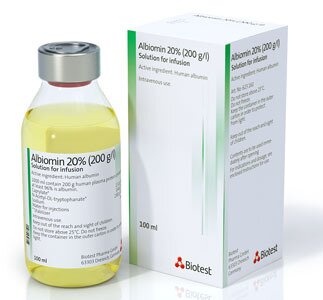

ALBIOMIN 20% (200 g/L) SOLUTION FOR INFUSION

Ask a doctor about a prescription for ALBIOMIN 20% (200 g/L) SOLUTION FOR INFUSION

How to use ALBIOMIN 20% (200 g/L) SOLUTION FOR INFUSION
Introduction
Package Leaflet: Information for the User
Albiomin 20% (200 g/l), Solution for Infusion
Human Albumin
Read all of this leaflet carefully before you start using this medicine because it contains important information for you.
- Keep this leaflet, you may need to read it again.
- If you have any further questions, ask your doctor or nurse.
- If you get any side effects, talk to your doctor or nurse. This includes any possible side effects not listed in this leaflet. See section 4.
Contents of the pack
- What Albiomin 20% (200 g/l) is and what it is used for
- What you need to know before you use Albiomin 20% (200 g/l)
- How to use Albiomin 20% (200 g/l)
- Possible side effects
- Storage of Albiomin 20% (200 g/l)
- Contents of the pack and other information
1. What Albiomin 20% (200 g/l) is and what it is used for
Albiomin 20% (200 g/l) is a solution for infusion (into a vein). 1 litre of solution contains 200 g of human plasma protein of which at least 96% is human albumin.
Albiomin 20% (200 g/l) is used to restore and maintain blood volume when there is a low blood volume and the use of a colloid, such as albumin, is necessary.
2. What you need to know before you use Albiomin 20% (200 g/l)
Do not use Albiomin 20% (200 g/l)
- if you are allergic to albumin preparations or to any of the other components of this medicine (listed in section 6).
Warnings and precautions
In case of suspected allergic reactions or anaphylactic reactions, the infusion must be stopped immediately. In case of shock, standard medical guidelines for the treatment of shock should be followed.
The infusion will also be stopped if you develop any of the following disorders as signs of cardiovascular overload (hypervolemia):
- Headache
- Dyspnoea (difficulty breathing)
- Jugular venous congestion (fluid accumulation in a neck vein)
- Increased blood pressure
- Increased venous pressure (increased pressure in the veins)
- Pulmonary oedema (fluid in the lungs)
Tell your doctor if you have any of the following conditions:
- heart failure (decompensated heart failure)
- high blood pressure (hypertension)
- dilated veins in the oesophagus (oesophageal varices)
- fluid in the lungs (pulmonary oedema)
- tendency to abnormal or spontaneous bleeding (haemorrhagic diathesis)
- severe reduction of red blood cells (severe anaemia)
- reduced or absent urine production (renal and post-renal anuria)
He/She will take the necessary precautions. Your doctor will monitor you to supervise your circulatory situation with electrolyte balance and blood volume.
Information on the transmission of infectious agents
When human blood or plasma-derived medicines are administered, certain measures must be taken to prevent infections from being passed on to patients. These measures include:
- careful selection of donors to exclude those who are at risk of being carriers of infectious diseases,
- testing for specific infection markers in individual donations and in plasma pools,
- inclusion of stages in the manufacturing process to eliminate/inactivate viruses.
Despite this, when human blood or plasma-derived medicines are administered, the possibility of transmitting infectious agents cannot be completely excluded. This also applies to emerging or unknown viruses or other types of infections.
There are no reports of virus transmission with albumin manufactured according to the requirements and processes established in the European Pharmacopoeia.
It is strongly recommended that each time you are given a dose of Albiomin 20% (200 g/l), the name and batch number of the product should be recorded in order to maintain a record of the batches used.
Use of Albiomin 20% (200 g/l) with other medicines
Tell your doctor if you are using or have recently used or might have to use any other medicines.
Pregnancy, breast-feeding and fertility
If you are pregnant or breast-feeding, think you may be pregnant or are planning to have a baby, ask your doctor for advice before taking this medicine. Your doctor will decide whether Albiomin 20% (200 g/l) can be used during pregnancy and breast-feeding.
Driving and using machines
Albiomin 20% (200 g/l) has no effects on the ability to drive and use machines.
Albiomin 20% (200 g/l) contains sodium
This medicine contains approximately 140 mg of sodium (main component of cooking/table salt) in each 50 ml vial. This is equivalent to 7.0% of the maximum recommended daily intake of sodium for an adult.
This medicine contains approximately 280 mg of sodium (main component of cooking/table salt) in each 100 ml vial. This is equivalent to 14.0% of the maximum recommended daily intake of sodium for an adult.
3. How to use Albiomin 20% (200 g/l)
Treatment with Albiomin 20% (200 g/l) is usually given in a hospital by a doctor or nurse.
Human albumin can be administered directly into a vein or diluted in 0.9% sodium chloride.
Dose and frequency of administration
The amount of Albiomin 20% (200 g/l) you receive will depend on your size, disease and fluid or protein losses.
Your doctor will determine the amount of Albiomin 20% (200 g/l) and the frequency of administration to achieve the correct levels in the blood.
If you use more Albiomin 20% (200 g/l) than you should
This is very unlikely, but if it happens, your doctor will know what to do.
If you have any further questions on the use of this medicine, ask your doctor or nurse.
In case of overdose or accidental ingestion, call the Toxicology Information Service immediately, telephone 915620420.
4. Possible side effects
Like all medicines, this medicine can cause side effects, although not everybody gets them.
The following side effects have been reported:
- redness,
- skin rash (urticaria),
- fever and nausea
These occur rarely.
Very rarely, serious reactions such as shock may occur. If this happens, the infusion will be stopped and appropriate treatment will be started.
Reporting of side effects
If you experience any side effects, talk to your doctor or nurse, even if they are not listed in this leaflet. You can also report side effects directly through the Spanish Pharmacovigilance System for Human Use Medicines: http:\\www.notificaram.es. By reporting side effects, you can help provide more information on the safety of this medicine.
5. Storage of Albiomin 20% (200 g/l)
Keep this medicine out of the sight and reach of children.
Do not use this medicine after the expiry date which is stated on the label and carton.
Keep the vial in the outer carton to protect it from light.
Do not store above 25°C.
Do not freeze.
Once opened, the product should be used immediately.
Before administration, check that the solution is clear. The product should not be used if the solution is cloudy or has visible particles.
Medicines should not be disposed of via wastewater or household waste. Ask your pharmacist how to dispose of medicines no longer required. This will help protect the environment.
6. Contents of the pack and other information
Composition of Albiomin 20% (200 g/l)
Each 50 ml vial of solution contains 10 g of human plasma protein, of which at least 96% is human albumin.
Each 100 ml vial of solution contains 20 g of human plasma protein, of which at least 96% is human albumin.
The other components are sodium caprylate (16 mmol/l), sodium chloride (63 mmol/l), N-acetyltryptophanate (16 mmol/l) and water for injections.
Appearance of Albiomin 20% (200 g/l) and pack contents
Clear and slightly viscous liquid; it is practically colourless, yellow, amber or green.
50 ml glass vial
100 ml glass vial
Marketing Authorisation Holder and Manufacturer
Biotest Pharma GmbH
Landsteinerstraße 5
63303 Dreieich
Germany
Phone: +49 6103 801-0
Fax: +49 6103 801-150 Email: [email protected]
For more information on this medicine, contact the local representative of the Marketing Authorisation Holder:
Grifols Movaco, S.A.
Can Guasc, s/n – Parets del Vallès
08150 Barcelona
Spain
Date of last revision of this leaflet: 05/2020
This information is intended only for healthcare professionals:
Special warnings and precautions for use
The colloid osmotic effect of human albumin at 200 g/l is approximately four times that of blood plasma. Therefore, when concentrated albumin is administered, adequate hydration of the patient must be ensured. Patients must be carefully monitored to avoid circulatory overload and hyperhydration.
Albumin solutions must not be diluted with water for injectable preparations, as this may cause haemolysis in the recipients.
If relatively large volumes are replaced, coagulation and haematocrit controls must be performed. Precautions must be taken to ensure adequate substitution of other blood constituents (coagulation factors, electrolytes, platelets and red blood cells).
Hyperhydration may occur if the dose and infusion rate are not adjusted to the patient's circulatory situation.
There are no confirmed cases of virus transmission with albumin manufactured according to the specifications and processes established in the European Pharmacopoeia.
Interaction with other medicines and other forms of interaction
No specific interactions of human albumin with other medicines are known.
Posology and method of administration
Posology
The necessary dose will be based on the measurement of circulating volume and not on the determination of plasma albumin levels.
If human albumin is to be administered, the patient's haemodynamic situation must be regularly assessed; this may include determination of:
- blood pressure and pulse
- central venous pressure
- pulmonary artery wedge pressure
- diuresis
- electrolytes
- haematocrit/haemoglobin
Method of administration
Intravenous route.
The solution can be administered directly intravenously or diluted in an isotonic solution (e.g. 0.9% sodium chloride).
During plasma exchange, the infusion rate must be adjusted to the exchange rate.
Instructions for handling
Albumin solutions must not be diluted with water for injectable preparations, as this may cause haemolysis in the recipients.
If large volumes are administered, before use, the product should be brought to room or body temperature.
The solution should be clear or slightly opalescent. Do not use solutions that are cloudy or have deposits, which may indicate that the protein is unstable or the solution has been contaminated.
Once the vial is opened, the contents should be used immediately.
Disposal of the unused medicine and all materials that have come into contact with it will be carried out in accordance with local regulations.
- Country of registration
- Active substance
- Prescription requiredYes
- Manufacturer
- This information is for reference only and does not constitute medical advice. Always consult a licensed doctor before taking any medication. Oladoctor is not responsible for medical decisions based on this content.
- Alternatives to ALBIOMIN 20% (200 g/L) SOLUTION FOR INFUSIONDosage form: INJECTABLE PERFUSION, 200 g/lActive substance: albuminManufacturer: Csl Behring GmbhPrescription requiredDosage form: INJECTABLE PERFUSION, 200 g/lActive substance: albuminManufacturer: Octapharma S.A.Prescription requiredDosage form: INJECTABLE PERFUSION, 50 g/lActive substance: albuminManufacturer: Octapharma S.A.Prescription required
Alternatives to ALBIOMIN 20% (200 g/L) SOLUTION FOR INFUSION in other countries
The best alternatives with the same active ingredient and therapeutic effect.
Alternative to ALBIOMIN 20% (200 g/L) SOLUTION FOR INFUSION in Poland
Alternative to ALBIOMIN 20% (200 g/L) SOLUTION FOR INFUSION in Ukraine
Online doctors for ALBIOMIN 20% (200 g/L) SOLUTION FOR INFUSION
Discuss dosage, side effects, interactions, contraindications, and prescription renewal for ALBIOMIN 20% (200 g/L) SOLUTION FOR INFUSION – subject to medical assessment and local rules.














